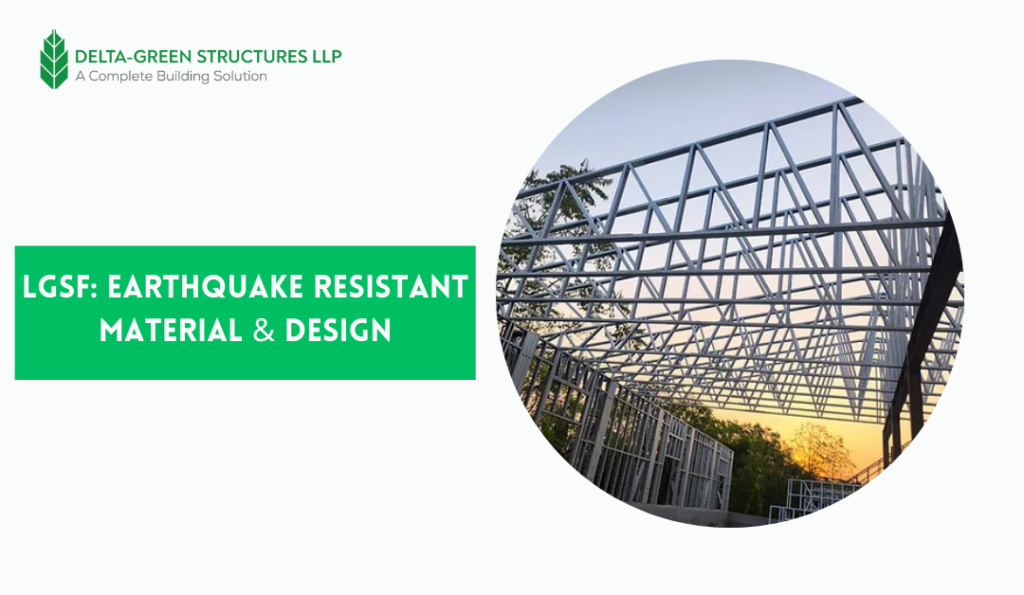Light Gauge Steel Framing (LGSF) is a reliable and efficient construction method, especially in earthquake-prone areas. With the growing need for safe and sustainable building solutions, LGSF has become a popular choice due to its strength, flexibility, and quick construction. Delta Green Structures, based in Siliguri, is a trusted name in LGSF manufacturing and provides services across India. This article explains why LGSF is earthquake-resistant, focusing on its material and design.
Introduction to LGSF:-
LGSF, or Light Gauge Steel Framing, is a modern construction technique using lightweight steel sections to create the structural framework of buildings. Unlike traditional construction methods, LGSF is faster, more eco-friendly, and better equipped to handle natural disasters like earthquakes. Its use of steel and smart design makes it ideal for regions with high seismic activity.
During earthquakes, traditional buildings often suffer damage or collapse due to their rigidity and weight. LGSF structures, however, are designed to flex and absorb seismic energy, reducing the risk of failure. Let’s examine the materials and designs that make LGSF earthquake-resistant.
Material: The Backbone of LGSF’s Earthquake Resistance
The materials used in LGSF construction play a key role in its earthquake-resistant properties. Here are the main features:
1. Lightweight Steel:- LGSF uses high-strength, lightweight steel. Its strength-to-weight ratio ensures the structure can handle heavy loads without adding unnecessary weight. Lighter buildings experience less force during earthquakes, reducing the risk of collapse.
2. Ductility of Steel:- Steel’s ductility allows it to bend and stretch under pressure without breaking. This property helps LGSF structures absorb and dissipate seismic energy, preventing severe damage.
3. Corrosion Resistance:-LGSF materials are coated with protective layers like galvanization to resist corrosion. This ensures durability and safety even in harsh environments, enhancing the building’s reliability.
4. Fire Resistance:- While not directly related to earthquakes, the fire-resistant properties of LGSF materials provide additional safety. Steel resists ignition, offering protection in scenarios where fires may follow an earthquake.
Design: Engineering Earthquake-Resilient Structures
Thoughtful design is crucial to the earthquake-resistant nature of LGSF buildings. Here are the key design features:
1. Flexibility and Load Distribution:- LGSF structures are designed to flex, distributing seismic forces evenly. This prevents stress from concentrating in one area, reducing the likelihood of failure.
2. Connection Systems:- The joints and connectors in LGSF frameworks are designed to be strong yet flexible. These advanced systems allow the building to move slightly during an earthquake without breaking apart.
3. Lightweight Design:- The lightweight nature of LGSF materials lowers the building’s overall mass, reducing the seismic forces acting on it. A low center of gravity further enhances stability.
4. Modular Construction:- LGSF components are prefabricated off-site and assembled on-site, ensuring precise engineering and alignment. This uniformity strengthens the structure and improves earthquake resistance.
5. Seismic Zoning Considerations:- LGSF designs can be customized based on local seismic activity and soil conditions. By adhering to regional building codes, it ensures maximum safety and compliance.
6. Shear Walls and Bracing:-Thoughtful design is crucial to the earthquake-resistant nature of LGSF buildings. Here are the key design features:
Advantages of LGSF in Earthquake-Prone Areas
- Fast Construction: LGSF structures are quick to assemble, reducing time spent in high-risk zones.
- Cost-Effective: Lightweight materials and efficient designs lower transportation and labor costs.
- Eco-Friendly: Steel is recyclable, making LGSF a sustainable choice.
- Versatile: Suitable for residential, commercial, and industrial projects, LGSF offers diverse solutions.
LGSF is a revolutionary construction method, especially for earthquake-prone regions. Its combination of lightweight, high-strength steel and innovative design principles ensures safety, durability, and sustainability. Delta Green Structures, a leading LGSF manufacturer, delivers solutions tailored to India’s diverse needs. By choosing LGSF, you invest in a safe and resilient future.

